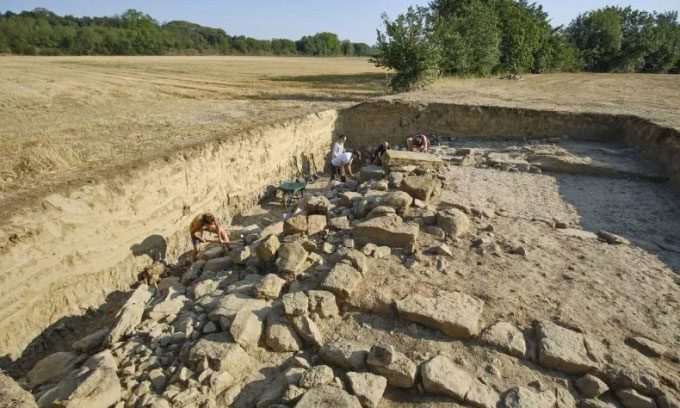Scientists Discover a Gateway Built from Large Stones Leading into the Ancient City of Ullastret, Once Home to 6,000 Inhabitants.
The City of Ullastret, which existed at least since the 6th century BC and was abandoned by the 2nd or 3rd century BC, was uncovered in the 1930s. Researchers have been excavating the site for decades, and recently, they discovered a massive gateway leading into the city beneath Lake Ullastret, a water body that dried up over 100 years ago in Spain, as reported by Newsweek on July 7.

Experts excavating the entrance to the ancient city beneath the dried-up Ullastret Lake. (Photo: Catalonia Archaeological Museum)
“This is one of the most significant discoveries made by our team in recent years.” The Catalonia Archaeological Museum stated in a post on their Facebook page.
The gateway leads to the lower area of the city and is surrounded by enormous stone blocks. It was discovered during an excavation conducted by the Catalonia Archaeological Museum and SPAHI from June 6 to 30 at Lake Ullastret. Previously, in 2016, archaeologists had hypothesized that there might be a grand entrance to the city beneath the lake.
The entrance consists of two parallel branches, each 2.3 meters wide, constructed from well-finished large stone blocks, positioned perpendicular to the wall enclosing the western part of the city. These walls surround a corridor 4 meters wide, serving as the starting point for one of the city’s main roads.
The city was built by the Indigetes tribe and was the largest urban settlement in Catalonia at that time. Ruins previously discovered in the city include houses, granaries, and temples. Experts believe that at its peak, the city hosted over 6,000 residents.
The newly discovered entrance has been completely blocked by stone blocks. The archaeological team suggests this was done to seal off the city after it was abandoned. The city was deserted by the late 3rd century or early 2nd century BC, possibly due to the Second Punic War in the northeast of the Iberian Peninsula. This conflict lasted from 218 to 201 BC, between the Carthaginian civilization, which dominated much of North Africa and Spain, and the Romans, who controlled Italy and the islands of Sardinia and Corsica at that time.
Archaeologists hope to continue studying this site to gain further insights into the lives of its inhabitants and the reasons behind their abandonment of the city.


















































